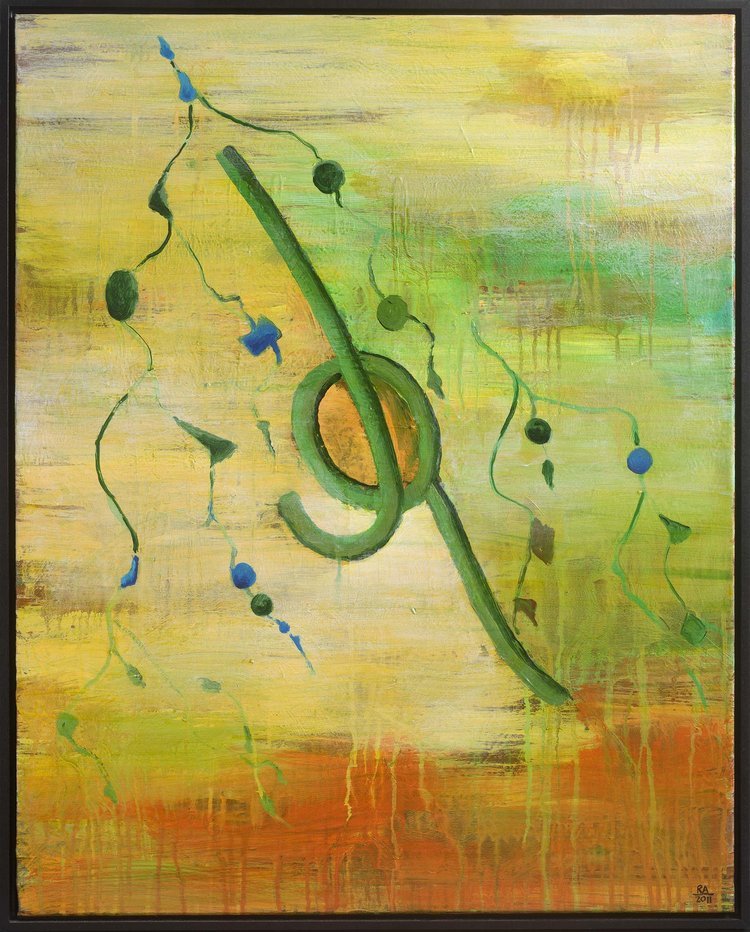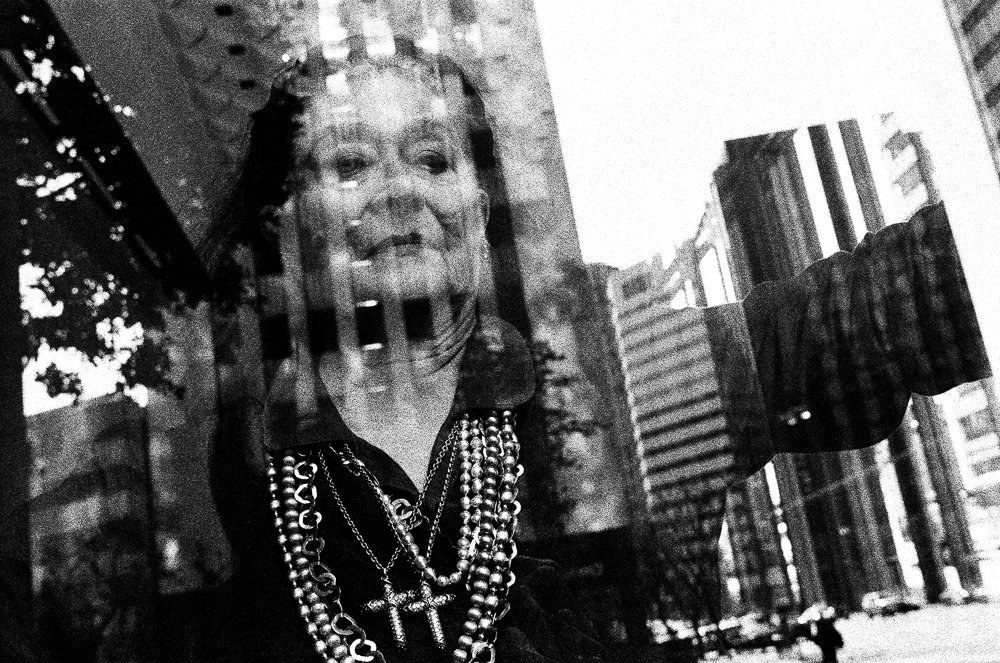Joan Agajanian Quinn’s room appears just as I imagine the rest of her home: overflowing with art. Paintings stacked on the floor and furniture lean against other paintings. I recognize the style of one painting sitting on a bed headboard. Its bright colors and bold lettering—JQ, Quinn’s initials—surrounded by wavy, wispy lines resemble a painting in a catalog we both flip through.
“All those funny little things hanging are the pieces of jewelry that he would see me wear,” Quinn says, peering at the catalog through round, cheetah print glasses framed by hot pink hair.

The two paintings are by Ruben Amirian, an Iranian-born Armenian artist living in the United States. The painting in the catalog is part of an exhibition featuring Armenian artists titled “Discovering Takouhi: Portraits of Joan Agajanian Quinn,” currently on display at the Armenian Museum of America in Watertown, Massachusetts.
Portraits of Quinn are legendary in the art world. Quinn was both a supporter and muse for emerging Californian artists who attended parties at her home in Beverly Hills—like a “modern-day Gertrude Stein,” exhibition co-curator Natalie Varbedian says. Among her 300-plus friends who painted portraits of her over the years include David Hockney, Jean-Michel Basquiat and Andy Warhol.

Quinn and her late husband Jack amassed an extensive home collection of artwork by such artists that was publicly displayed for the first time at the Bakersfield Museum of Art in 2021. The exhibition, titled “On the Edge: Los Angeles Art 1970s-1990s from the Joan and Jack Quinn Family Collection,” premiered at the Armenian Museum of America in June 2022 alongside a new companion exhibition focusing on portraits of Quinn by Armenian artists.

The artwork in “Discovering Takouhi” ranges vastly in genre and medium. A black-and-white photo collage by Ara Oshagan juxtaposes an image of Quinn with her arms outstretched with the buildings of Westwood. Silvina Der-Meguerditchian frames a smiling photo of Quinn, with her hands in prayer and a halo painted atop her head, with deep red and blue yarn. Basic red, green, blue and black lines on a stark white canvas form an abstract face, painted by Aram Saroyan.
“It’s very much in the style of his father William Saroyan, which is interesting because Aram was never a painter,” Quinn says. “I love the way he did it, because it was the colors that he sees in me.”
Color is one of the few common threads that connects many of the paintings, alongside Quinn’s striking jewelry, including the trademark cross that hangs around her neck. Exhibit co-curator Gina Grigorian notices the deep reds, royal purples and vivid oranges that the paintings share, a reflection of Quinn’s vibrant personality.

“A lot of people feel things through color,” Grigorian says.
The artwork is so diverse, because Quinn granted the artists the freedom to experiment in their own styles and depict Quinn as they perceive her, Varbedian says, “not feeling like they have to represent her in the way that she wanted.” Walking through the eclectic exhibition, I have to remind myself that all 28 paintings, in their impressive variation, represent the same woman.
Quinn says the portraits are not really about her, but about the artists.
“It’s not a narcissistic collection. It’s not about making paintings of me,” Quinn says. “It’s more like a project to see how you could give him a bowl or fruit or a vase of flowers and see how those 300 people paint that one vase or that bowl.”
The exhibition introduces art lovers to another aspect of Quinn with which they may not have been familiar—her Armenian heritage. The name of the exhibition is inspired by Quinn’s Armenian name from birth, Takouhi, which means queen, “a name that suits a woman who embraces her Armenian heritage and ensures Armenian voices are elevated,” the curator’s statement reads.
Many in the contemporary art world may be acquainted with Quinn because of her monumental work on behalf of the California art scene, yet may not know about her Armenian background, Grigorian says. Through the exhibition, viewers discover Quinn’s multi-faceted inner world, which includes her pride in her Armenian ancestry and her decades-long commitment to supporting Armenian artists.
“Everyone knows Joan Quinn. Do people know Takouhi?” Grigorian poses.
The exhibition not only connects art lovers to Armenian culture, but also Armenians to the contemporary art scene. Jason Sohigian, executive director at the Armenian Museum of America, says that the exhibit has brought many people familiar with Quinn’s legacy to the museum for the first time. It has also introduced Quinn to many Armenians who visit the museum for its collection of historical Armenian objects and are surprised upon wandering to the third floor to be greeted with names like Warhol and Hockney.
“We couldn’t have gotten artists of this caliber at the museum if it wasn’t for Joan Quinn,” Sohigian says, while admiring an illustration of Quinn’s hands adorned with her many rings and bracelets drawn by Basquiat. “I don’t think you’ll see a Basquiat in Watertown again.”
Quinn’s decision to bring the two exhibitions, jointly the largest at the Armenian Museum of America in 50 years, to Massachusetts seems to me like the latest example of her penchant for forging connections within the art world. Quinn selected Varbedian, who lately completed her master’s in art history at UC Davis, and Grigorian, a recent graduate of Parsons School of Design, to co-curate “Discovering Takouhi,” giving these two young Armenian women the opportunity to exercise their talents in curation for the first time.
“She tries to help everybody, help create connections. Even being so generous with me, after grad school, knowing that she wanted me to work on this exhibit,” says Varbedian, who wrote her master’s thesis about Quinn’s pivotal role in the Los Angeles art scene. “She doesn’t forget people.”
“On the Edge: Los Angeles Art 1970s-1990s from the Joan and Jack Quinn Family Collection” and its companion exhibition “Discovering Takouhi: Portraits of Joan Agajanian Quinn” will be on view in the Adele and Haig Der Manuelian Galleries at the Armenian Museum of America until November 30.



thank you lillian…well done !
your style of prose captured your observations and descriptions in a brilliant way.
i know because of the armenian weekly, the artists and curators of Takhoui will get recognition from your article. best, joan